How To Create An Inventory Transfer On Shopify
In this article, we provide an ultimate guide on creating an inventory transfer on Shopify and its benefits.
What Does Transfer Inventory Between Shopify Stores Mean?
Transferring inventory between Shopify stores is a process businesses employ to optimize their stock distribution across various locations within the Shopify platform. This mechanism facilitates the seamless movement of products from a designated source location to a targeted destination, allowing businesses to maintain optimal inventory levels and enhance operational efficiency.
For example, a thriving online retailer operates multiple brick-and-mortar stores in different cities. If one store experiences a surge in demand for a particular product while another has excess stock, the retailer can initiate an inventory transfer. This means reallocating the surplus stock from the second store (source location) to the one facing increased demand (destination location).
By executing this transfer, the retailer achieves several goals.
- Firstly, it ensures that the high-demand store remains well-stocked, meeting customer needs promptly.
- Secondly, excess inventory in the source location is effectively utilized, preventing overstock issues and potential losses.
In this way, inventory transfers on Shopify become a dynamic tool for businesses to respond to fluctuations in demand, streamline their stock distribution, and maximize the efficiency of their entire retail network.
Beyond demand adjustments, businesses also utilize inventory transfers for organizational purposes. For instance, when consolidating inventory from various suppliers or preparing for seasonal shifts, the ability to transfer stock between locations proves invaluable. This ensures that each store is well-prepared for specific events or changes in customer preferences.
How To Create A Transfer On Shopify
In this detailed guide, we’ll explore each process step, providing examples and practical insights for a more comprehensive understanding.
Step 1: Create a new transfer
- Go to Products > Transfers.
- Click the Create transfer button.
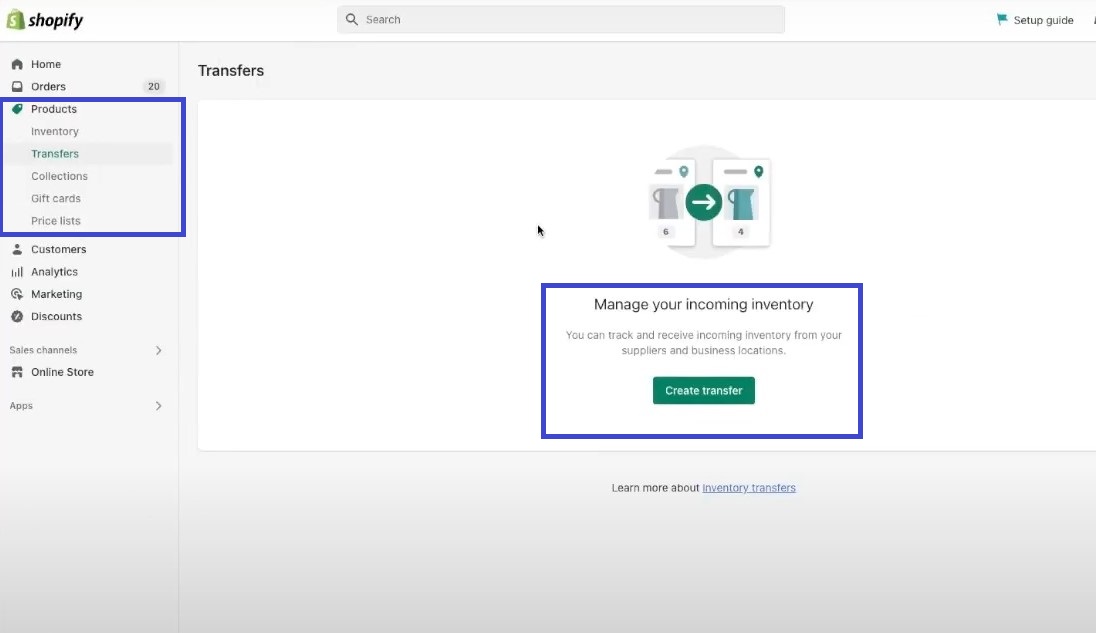
- Select the Origin location and Destination location.
- For instance, Imagine you have two stores, one in New York and another in California. You want to transfer popular winter apparel from California to New York as winter approaches there. Select the Origin (California) and Destination (New York) locations.
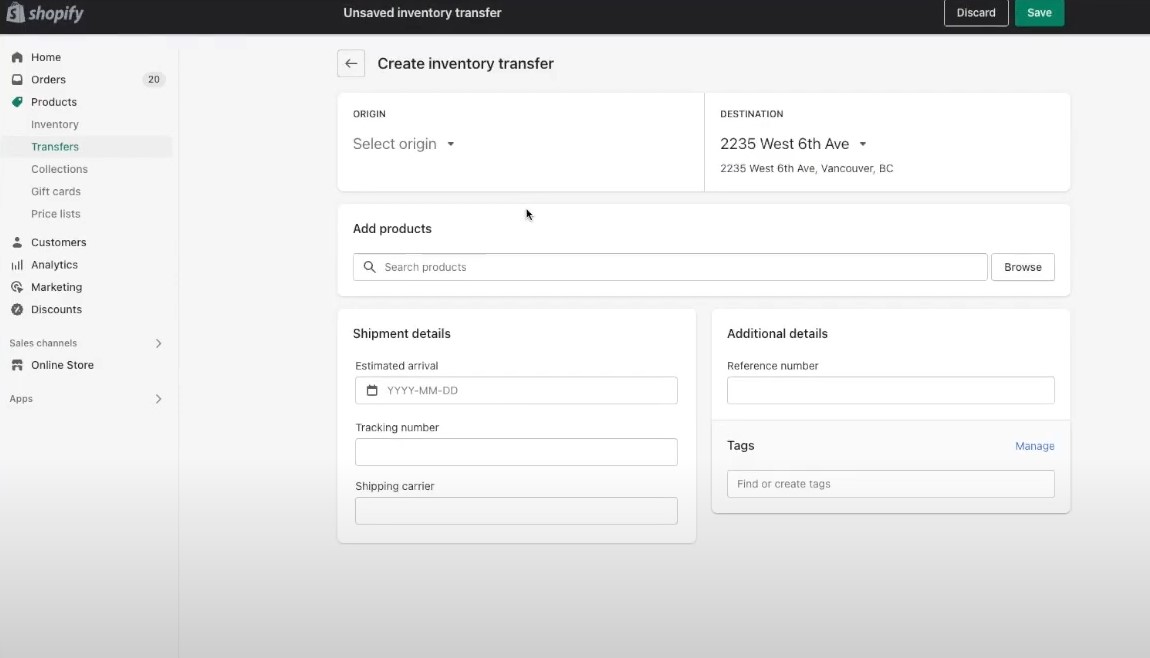
- Click the Add Products button.
- Select the products you want to transfer and enter the quantities.
- Click the Add button.
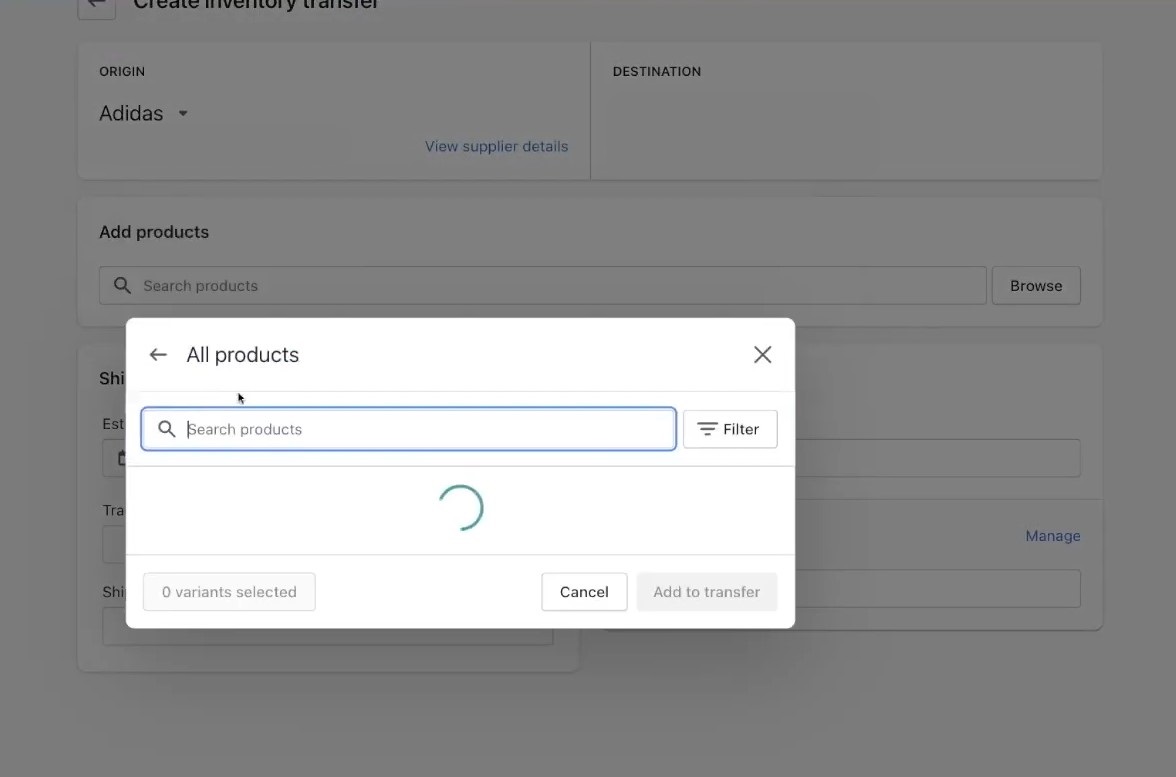
- Enter the Shipping information and Reference number.
- Click the Save button.
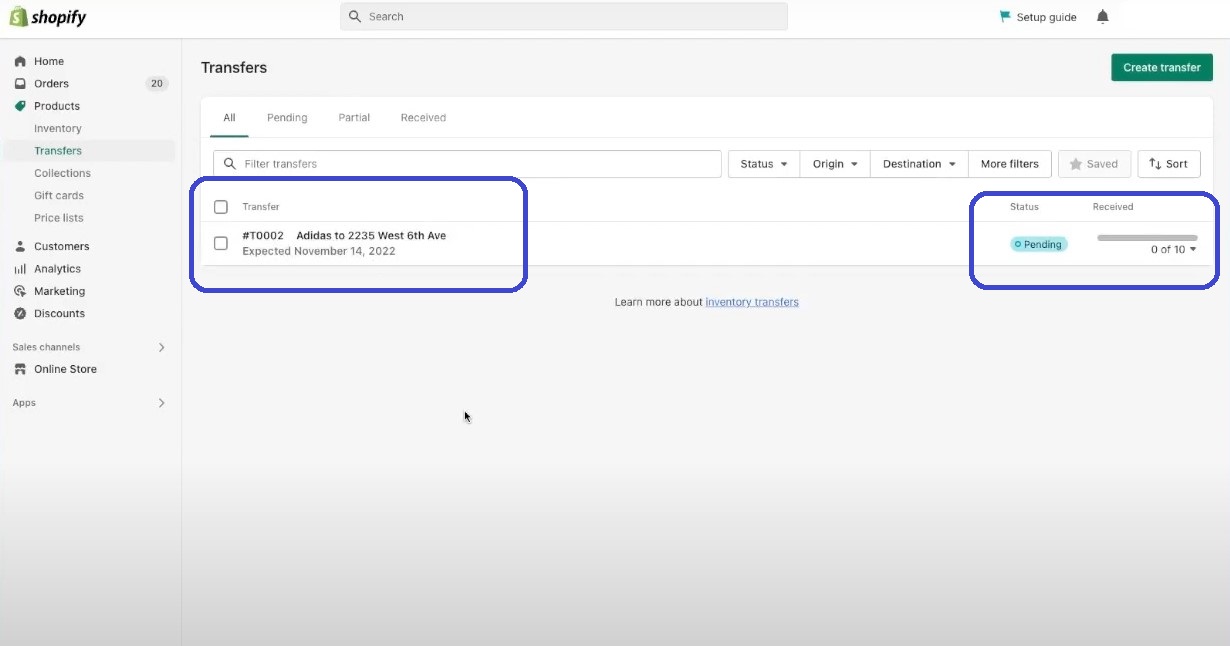
Step 2: Duplicate an existing transfer
- Go to Products > Transfers.
- Click the Transfer you want to duplicate. For example, you previously transferred 50 jackets from California to New York. Now, you want to duplicate this for another batch.
- Click the Duplicate button.

- Edit the transfer as needed.
- Click the Save button.
Step 3: Mark a transfer as pending
- Go to Products > Transfers.
- Click the Transfer you want to mark as pending.
- Click the Mark as a Pending button. It means you initiated a transfer from the supplier, and you want to mark it as pending until the stock physically arrives.
What information is needed to create a transfer?
- The origin and destination locations
- The products and quantities to be transferred
- The shipping details
What products can be transferred?
All products can be transferred, except for products that are set to Inventory managed by Shopify.
How to add products to a transfer
- Go to Products > Transfers.
- Click the Transfer you want to add products to.
- Click the Add Products button.
- Select the products you want to transfer and enter the quantities.
- Click the Add button.
How to enter quantities: Enter the quantity of each product you want to transfer. You can use the + and - buttons to increase or decrease the quantity. For example, If you have 30 sunglasses, enter 30 in the quantity field.
How to enter shipping information: Enter the shipping provider, tracking number, and shipping date.
How to enter a reference number: Enter a reference number for the transfer. This is optional. Reference numbers can be used to track specific batches or orders. For instance, “Batch_Summer_Sunglasses_2023.”
How to save a transfer: Click the Save button.
How to view incoming inventory quantity
- Go to Products > Inventory.
- Click the Location you want to view.
- The Incoming inventory quantity is displayed next to each product. After completing the transfer, you’ll see the added quantity of sunglasses in the New York store.
Additional tips
- You can filter transfers by origin location, destination location, and status.
- You can export transfers to a CSV file.
- You can use the Shopify API to create and manage transfers.
How To Receive An Inventory Transfer
When you receive an item in your transfer, the available quantity is updated on your Inventory page. If you reject an item, such as in the case of damage, it won’t impact your inventory quantity. Before proceeding, ensure that inventory tracking is enabled for your products and variants.
Before initiating the receipt of a transfer, verify the accuracy of product quantities in the transfer. Once received and saved, a transfer cannot be deleted or edited. If errors are detected, you can undo received quantities or manually adjust your inventory.
Steps:
- From your Shopify admin, go to Products > Transfers.
- Click the transfer that you want to receive. For example, let’s say you initiated a transfer to restock your New York store with 50 winter jackets from your California store. Click on this specific transfer.
- Click “Receive inventory.”
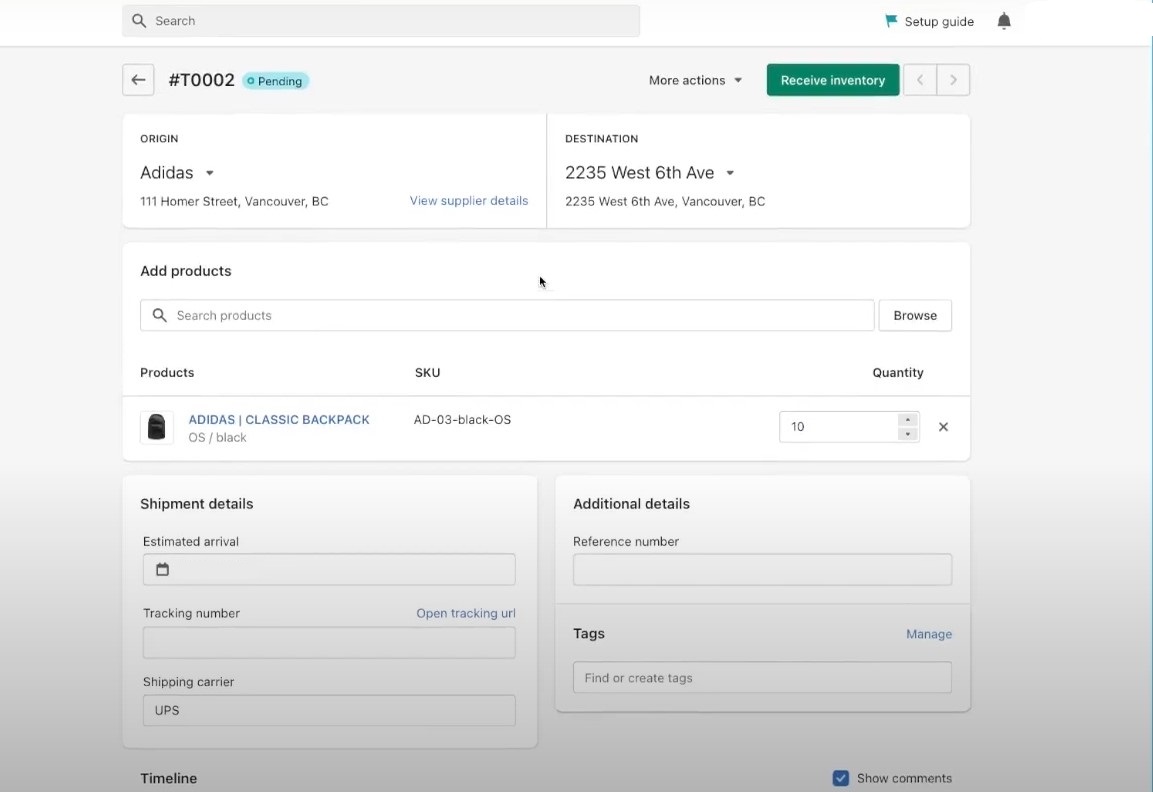
-
Accept Items:
-
Manually enter the number of items you're accepting. For example, Manually enter "40" jackets that are in good condition.
-
OR Click "All" in the Accept column to accept all for that line item.
-
OR Click "Accept all unreceived" at the top to accept all quantities that haven't been received yet, then click "Accept and save."
-
-
Reject Items:
-
Manually enter the number of items you're rejecting. For instance, unfortunately, 5 jackets are damaged. Manually enter "5" in the Reject column.
-
OR Click "All" in the Reject column to reject all for that line item.
-
OR Click "Reject all unreceived" at the top to reject all quantities that haven't been received yet, then click "Accept and save."
-
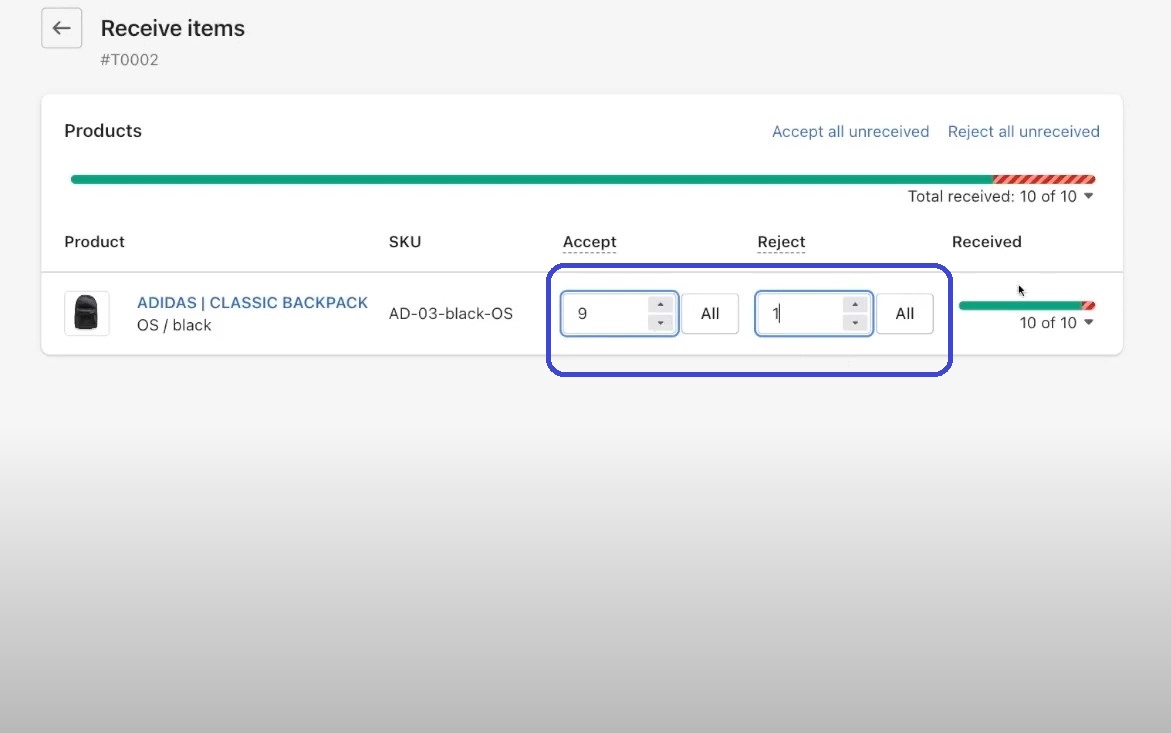
- Save the Receipt: If available, click “Save.”
- Adjust Available Quantity: The available quantity for your products is adjusted based on the quantity of the product that you accept.
Efficiently managing your received inventory transfers ensures that your store’s stock levels remain accurate and up-to-date. This process allows you to promptly make products available for sale or address issues with damaged items, contributing to a streamlined and responsive inventory management system on Shopify.
Bottom Line
By mastering these steps, you empower your store with the agility to respond to demand fluctuations, prevent overstocking or understocking, and ultimately enhance the overall customer experience. We hope that you found our guide steps useful. Let us know if you want us to make any guidelines that you need.
FAQs
Can I transfer inventory between multiple locations?
Absolutely. Shopify allows seamless transfers between any active locations within your store. This flexibility ensures you can strategically manage your inventory across various physical or virtual storefronts.
Do I need to receive transfers manually?
Yes, manual confirmation is required to finalize the receipt of the transferred inventory. This manual step ensures accurate tracking and evaluation of the received items.
Can I view the transfer history?
Yes, you can access a complete history of all transfers within your Shopify admin. This feature provides a transparent record of your inventory movements and transactions.
What information is needed to create a transfer?
To create a transfer, you’ll need to specify the origin and destination locations, list the products and quantities to be transferred, and provide shipping details. Ensure inventory tracking is enabled for accurate management.
What products can be transferred?
All products can be transferred except for those set to “Inventory managed by Shopify.” This versatile feature enables the movement of various items between different locations.
How do I add products to a transfer?
Navigate to Products > Transfers, select the desired transfer, click “Add products,” and choose the products with their respective quantities. This step ensures you include the right items in the transfer.
Can I undo a transfer if there are errors?
While you cannot directly delete or edit a completed transfer, you can undo received quantities or manually adjust your inventory if errors are detected. This ensures the accuracy of your inventory records.
Are there any precautions before receiving a transfer?
Yes, before initiating the receipt of a transfer, ensure the product quantities in the transfer are accurate. Once received and saved, a transfer cannot be deleted or edited. Be cautious to avoid discrepancies in your inventory data.
How do I adjust available quantities after receiving a transfer?
The available quantity for your products is automatically adjusted based on the quantity of the product that you accept during the receipt process. This ensures real-time updates to your inventory levels.
Can I export transfer records for reference?
Yes, Shopify allows you to export transfer records to a CSV file. This feature facilitates comprehensive record-keeping and analysis of your inventory movements.
Related Posts:





